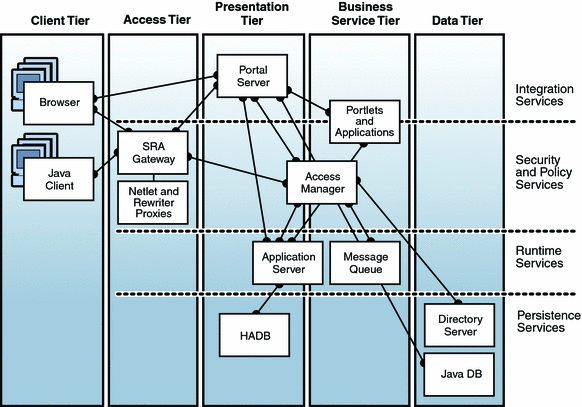Sun Java System Reference Configuration Series: Portal Service on Application Server Cluster
Logical Architecture Diagram
The various components that are needed to meet the reference configuration
requirements depend on their functions as distributed infrastructure services
or their roles within a tiered application framework. In other words, the
various components represent two views or dimensions that define a logical
architecture: the logical tier dimension and the distributed infrastructure
services dimension. These dimensions are described in the Sun Java Enterprise System 5 Update 1 Technical Overview.
The positioning of reference configuration components in such a two-dimensional
framework is shown in the following logical architecture diagram. Components
are placed within a horizontal dimension that represents standard logical
tiers and within a vertical dimension that represents infrastructure service
dependency levels. The positioning of a component in this matrix helps describe
the role that the component plays in the logical architecture.
For example, Access Manager is a component that is used by presentation
and business service tier components to provide security and policy infrastructure
services. However, Application Server is a component that is used by presentation
and business service tier components to provide distributed runtime services.
Figure 2–1 Logical Architecture of the Reference Configuration

A description of the tiers shown in Figure 2–1 is provided in the following table.
Table 2–1 Logical Tiers in the Architecture
Diagram
|
Tier
|
Description
|
|
Client
|
In the Client tier are applications that are used by users to access
portal services. In this reference configuration, the only client applications
that are used are a browser and a stand-alone Java client.
|
|
Access
|
This tier enables remote users to securely access their organization's
network and its services over the Internet. The Access tier acts as a communication
relay between the Client tier and the Presentation tier, and includes the
Portal Server Secure Remote Access components needed to securely access portal
services from the Internet.
|
|
Presentation
|
This tier provides aggregation and presentation capabilities that enable
users to access relevant information and personalize their desktop to best
meet their needs. In addition, this tier provides community, collaboration,
content, and knowledge management capabilities. This tier is implemented
using Portal Server software.
|
|
Business Service
|
This tier contains the back-end services that are aggregated and presented
to users by services in the Presentation tier. Examples of applications that
might reside in this tier include: email systems, calendar servers, and Enterprise
Resource Planning (ERP) applications (SAP, PeopleSoft, Siebel, and so forth.).
Also, this tier contains portlets and application components that are deployed
in a web container or application server.
|
|
Data
|
This tier provides a permanent repository that business services can
use to store persistent information. This tier includes Directory Server (used
by Access Manager and Portal Server to store user profiles) and Java DB (used
to store application data). High Availability Session Store (HADB), which
is used to store portlet session state, is placed in the Presentation tier
to indicate its functional relationship to Portal Server.
|

